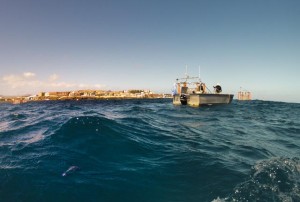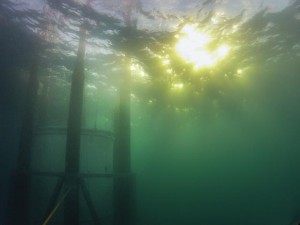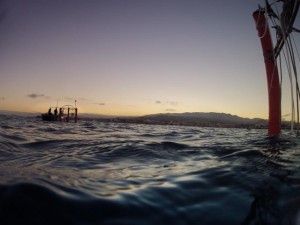„Did you see sharks“ or „Can I join you next time“ are usually the first reactions, you get to hear, when people realise you are one of the scientific divers for the KOSMOS team.
We have to admit that first of all the nicest thing is the water temperature, around 1°C when we started last year in Sweden, 18°C now at the beginning in Gran Canaria, so no dry suits anymore.
But still you need to wear a wetsuit, thanks to the thermal conductivity of water, even 18°C are cold after 1 hour with a 7mm neoprene.
The second issue is the protection of the skin, on board against the sun, in the water against the Portuguese man o´ war, also called “blue bottle” , see in the lower left corner of the picture below.
The last looks like a jelly but is really a siphonophore, a colony of highly specialised individuals (polyps) that are connected to such a degree that they cannot survive on their own. It has four kinds of polyps, one of them creates the “sail” making it float and drifting with the wind, the others are for catching food, reproduction and defence. Unfortunately everybody gets stung when touching the defence tentacles, which seems to be really painful, though none of us divers had to experience this yet.
Against sharks the wetsuit does not really help, or as far as we know we do not taste better without neoprene. But nevertheless so far sharks were only seen from boat and not under water (no picture), which is a pity, because most of the times meeting a shark under water is an amazing and exceptional occasion that no diver wants to miss and they are anyhow not as dangerous as the media wants to tell.
Apart from this you cannot see a lot out there, visibility is better than in the Baltic sea, usually around 15m, you can almost see one mesocosm from the other.
Every now and then you meet a school of small fishes and you see many translucent jelly like species of all kinds: salps, larvaceans, arrow worms and true jellies.
But still most important is to watch out for the blue bottle before sticking your head above the surface even in the evening.



Very nice comment about the diving experience around the mesocosms.
It is important to describe the human experience of swimming in the ocean environment. Most of us never get this experience and yet it is a vital part of any oceanographic experiment. Most of the time we get the chlorophyll, nutrient, density, etc. well measured in time and space. This can give us a publication, but it is really only part of the anatomy of an experiment, maybe only the skeleton. A part that is often lost is the impact on human feelings, the kind of reports the 19 century naturalists used to write. Your blog helps in providing this lost part. Kudos to you!